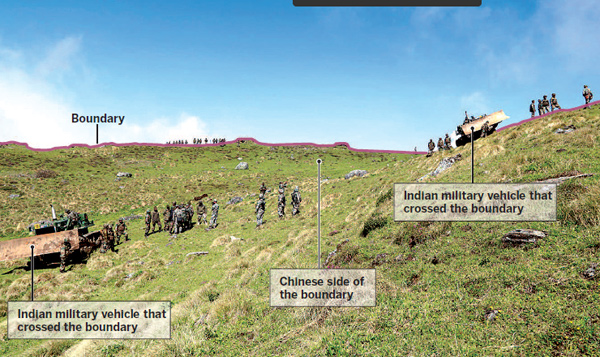India's trespassing justifications invalid
 |
|
A Foreign Ministry photo released shows Indian troops encroaching on Chinese territory. Provided to China Daily |
Calling Donglang a disputed area in spite of the consensus between China and Bhutan makes no sense at all, and India doing so does not justify the trespassing of its troops in the area. Apparently some Indian hardliners think creating the border dispute will help secure the "chicken's neck", the narrow corridor linking the Indian mainland to its northeastern states, as well as its regional dominance.
From the historical perspective, the 1890 Convention between Great Britain and China Relating to Sikkim and Tibet clearly delimited this part of the boundary between the Tibet autonomous region and India's Sikkim State, which remained an independent kingdom until 1975. Back in the 17th century when Bhutan and Sikkim were founded, both kingdoms maintained close political, economic and cultural ties with China's Tibet. The trilateral borders were also well established and acknowledged.
In 1794 China and Sikkim demarcated their border and kept it that way before the Convention between Great Britain and China Relating to Sikkim and Tibet was signed. After invading Bhutan, Sikkim and China's Tibet region, the British Empire forced the government of China's Qing Dynasty (1644-1911) to accept the British control over Sikkim and made Mount Gipmochi the "tri-junction" between China, Sikkim and Bhutan. The "revised" China-Sikkim border did demarcate certain Chinese territories on the Sikkim side, but Donglang was never one of them.
Ironically, India, which has advocated the Five Principles of Peaceful Coexistence along with China and Myanmar, has inherited the "colonial legacies" of "protecting" its small neighbors and acting tough against China since the British retreated in 1947, putting Sikkim under its "protection" and controlling Bhutanese diplomacy since 1950. Even though, the 1890 China-Sikkim boundary was deemed "indisputable" by former Indian prime minister Jawaharlal Nehru, according to his letters to former Chinese premier Zhou Enlai in 1959.
While prior to India's provocation the two nations looked set to deepen their partnership, its trespassing in Chinese territory risks opening a Pandora's box because it constitutes a violation of international laws and New Delhi's endorsement of the Five Principles of Peaceful Coexistence. Beijing has shown great sincerity in seeking to peacefully end the border farce, yet New Delhi refuses to withdraw its troops back onto Indian soil nor has it been shy about raising the 1962 war between China and India, and saying it is stronger than it was then.
If India sticks to its selective adoption and misinterpretation of the 1890 Convention, China also has the right to question the status of Sikkim and it could seek to restore the 1794 China-Sikkim border. Having successfully demarcated its land borders with 12 neighbors from Nepal to Vietnam, China needs no third-party intervention in its border negotiations with Bhutan, which is under constant pressure from India as it seeks to realize its consensus with Beijing.
The author is a researcher at the Research Center for Chinese Borderland History and Geography affiliated to the Chinese Academy of Social Sciences.
























